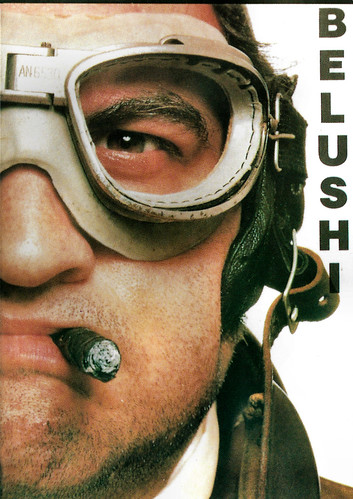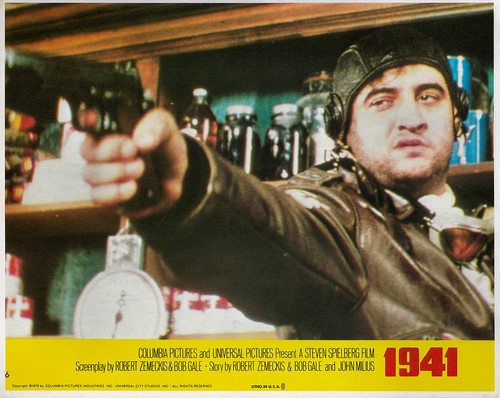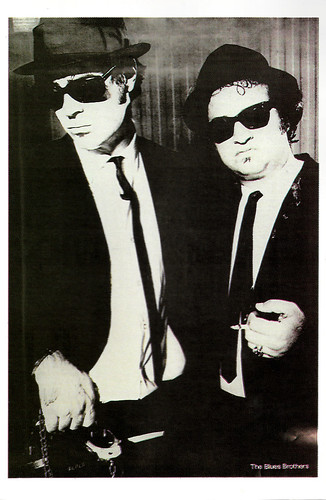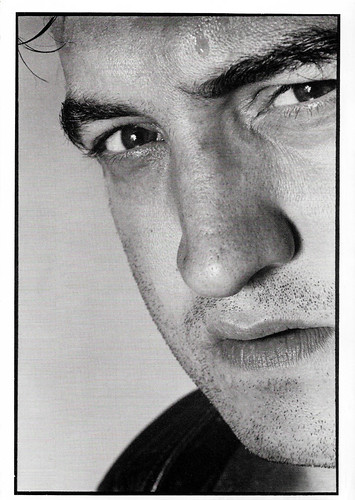
Italian postcard by Emilio Modric Editore, Ancona, no MX 018. Photo: Antony Baker. Dan Aykroyd and John Belushi in The Blues Brothers (John Landis, 1980).

British postcard by Box Office, no. BOPC 3034. Photo: John Belushi in 1941 (Steven Spielberg, 1979).
The perfect all-American boy
John Belushi was born in Chicago, Illinois, in 1949, to Agnes Demetri (Samaras) and Adam Anastos Belushi, a restaurant owner. His father was an Albanian immigrant, from Qytezë, and his mother was also of Albanian descent. He grew up in Wheaton, where the family moved when he was six.
Though a young hellion in grade school, John became the perfect all-American boy during his high school years where he was co-captain of the Wheaton Central High School football team and was elected homecoming king his senior year. He also developed an interest in acting and appeared in the high school variety show. Encouraged by his drama teacher, John decided to put aside his plans to become a football coach to pursue a career in acting.
After graduation in 1967, John performed in summer stock in rural Indiana in a variety of roles from Cardinal Wolsey in 'Anne of a Thousand Days' to a comic detective in 'Ten Little Indians'. In the fall of his freshman year at the University of Wisconsin at Whitewater, John changed his image into a bad-boy appearance by growing his hair long and began to have problems with discipline and the structure of attending classes.
In 1965, Belushi formed a band, the Ravens, together with four fellow high school students (Dick Blasucci, Michael Blasucci, Tony Pavilonis, and Phil Special). They recorded one single, 'Listen to Me Now/Jolly Green Giant'. Belushi played the drums and sang vocals. The record was not successful, and the band broke up when he dropped out of Wisconsin.
John spent the next two years at the College of DuPage, a junior college a few miles from his parents' Wheaton home, where his father began persuading him to become a partner in his restaurant, but John still preferred acting. He also attended the University of Wisconsin–Whitewater for a year, which inspired the famous Animal House scene of D-Day driving a motorcycle up the stairs.
Belushi started his own comedy troupe in Chicago, the West Compass Trio (named after the improvisational cabaret revue Compass Players active from 1955 to 1958 in Chicago), with Tino Insana and Steve Beshekas. Their success piqued the interest of Bernard Sahlins, the founder of The Second City improvised comedy enterprise, who went to see them performing in 1971 and asked Belushi to join the cast.
At Second City he performed in various on-stage comic performances with others, who included Harold Ramis and Joe Flaherty. John loved his life at Second City where he performed six nights a week, perfecting the physical 'gonzo' style of comedy he later made famous. A year later, John and his live-in girlfriend from his high school years, Judy Jacklin, moved to New York because John had joined the cast of 'Lemmings', a parody of Woodstock and a production of the humorous magazine National Lampoon. Besides Belushi, the young comedians Chevy Chase and Christopher Guest were also part of the cast. The off-Broadway rock musical revue was originally booked for a six-week run but played to full crowds for nearly 10 months.

American lobby card, no. 6. Photo: Columbia / Universal. John Belushi in 1941 (Steven Spielberg, 1979).

British postcard by Palm Pictures, no. C 26. Photo: Universal. Dan Aykroyd and John Belushi in The Blues Brothers (John Landis, 1980). Caption: Blues Brothers "Saint Helen".
The notorious, beer-swilling Bluto
In 1973, National Lampoon began broadcasting the comedy radio show The National Lampoon Radio Hour and John Belushi made regular appearances, along with Chevy Chase, Gilda Radner, Bill Murray and his brother Brian. Judy Jacklin, who also became the producer of the programme, married Belushi in 1976.
During a trip to Toronto to check out the local Second City cast in 1974, John met Dan Aykroyd. In 1975, Chevy Chase and writer Michael O'Donoghue recommended Belushi to Lorne Michaels as a potential member for a television show Michaels was about to produce for NBC called NBC's Saturday Night, later Saturday Night Live (SNL).
Michaels was initially undecided, as he was not sure if Belushi's physical humour would fit with what he was envisioning, but he changed his mind after giving Belushi an audition. Many employees of The National Lampoon Radio Hour moved to Saturday Night Live. Belushi, Radner, Chase, Dan Aykroyd, George Coe and others made up the cast of the sketch programme's first season.
The ground-breaking TV variety series made Belushi a star. His unpredictable, aggressively physical style of humour flowered on SNL. Two years later, Bill Murray also made his SNL debut. Over his four-year tenure at SNL, Belushi became one of the programme's best-loved comedians, thanks in part to his character Futaba, a samurai. With Aykroyd, Belushi created Jake and Elwood, the Blues Brothers. Originally intended to warm up the studio audience before broadcasts of SNL, the Blues Brothers were eventually featured as musical guests.
In 1978, while still working on Saturday Night Live (1975), John appeared in the films Old Boyfriends (Joan Tewkesbury, 1978) and Goin' South (1978) which starred and was directed by Jack Nicholson.
Director John Landis cast him in National Lampoon's Animal House (John Landis, 1978) as the notorious, beer-swilling "Bluto" and he stole the movie which portrays college fraternity shenanigans at a small college set in the year 1962. Upon its initial release, Animal House received generally mixed reviews from critics, but Time magazine and Roger Ebert proclaimed it one of the year's best movies. Filmed for $2.8 million, it is one of the most profitable movies of all time, garnering an estimated gross of more than $141 million.
In 1979, John Belushi along with fellow SNL regular Dan Aykroyd quit the series to pursue film projects. They appeared together in Steven Spielberg's financially unsuccessful comic war film 1941 (1979) and the next year, they co-starred in the massive hit The Blues Brothers (John Landis, 1980).

English postcard, no. REF 1009. Dan Aykroyd and John Belushi in The Blues Brothers (John Landis, 1980).

American postcard by Fotofolio, N.Y., N.Y, no. RE17. Photo: Marcia Resnick, 1981.
A pair of white soul men dressed in black suits, fedora hats and Rayban sunglasses
Around this time, John Belushi's drug use began escalating. Cocaine, which was ubiquitous in show-business circles in the 1970s, became his drug of choice. After he first experimented with cocaine in the mid-1970s, John almost immediately became addicted to it. His frequent cocaine sniffing binges became a source of friction between him and Judy, whom he married in 1976.
John's love for blues and soul music inspired the Blues Brothers. He and Aykroyd first appeared as Joliet Jake and Elwood Blues, a pair of white soul men dressed in black suits, skinny ties, fedora hats and Rayban sunglasses, as a warm-up act before the telecasts of Saturday Night Live (1975). Building on the success of their acts and the release of their album 'A Briefcase Full of Blues', John and Dan Aykroyd starred in the film, which gave John a chance to act with his favourite musical heroes including Ray Charles, James Brown and Aretha Franklin.
The Blues Brothers (John Landis, 1980) became his best-known film. Using some of his money, John Belushi bought his father a ranch outside San Diego for him to live. John helped set up some of his Chicago friends with their own businesses and even financially helped his younger brother, Jim Belushi, who followed his older brother's path to both Second City and Saturday Night Live.
In 1981, John appeared in the film Continental Divide (Michael Apted, 1981), playing a hard-nosed Chicago newspaperman who finds romance in Colorado with eagle expert Blair Brown. That same year, John and Dan Aykroyd appeared again in the comedy Neighbors (John G. Avildsen, 1981), which gave them a chance to reverse roles, with John playing a straight-arrow family man whose life is turned upside down when a wild family man (Aykroyd) moves in next door. However, neither film could repeat the success of The Blues Brothers.
In 1982, John checked into a bungalow at the Chateau Marmont, a popular celebrity hotel in Los Angeles. John's drug use had been steadily increasing for over a year now, which alarmed his wife and friends, but he continued to promise Judy that he would quit someday. On 5 March 1982, John Belushi was found dead of a drug overdose in his hotel room. He was 33. The local coroner gave the cause of death as a lethal injection of cocaine and heroin.
Several years later, John's drug dealing/drug user companion during his final weeks, Cathy Evelyn Smith, was tried and sentenced to three years in prison for supplying John with the drugs. Close friend James Taylor sang 'That Lonesome Road' at a memorial service at Martha's Vineyard cemetery where John was buried. Dan Aykroyd wrote the screenplays for Ghostbusters and Spies Like Us. In both films, he had foreseen a role for Belushi. The role in Ghostbusters was eventually played by Bill Murray, and in Spies Like Us by Chevy Chase. Belushi was posthumously honoured with a star on the Hollywood Walk of Fame in 2004.

British postcard by Heroes, London, no. SPC 2172. Dan Aykroyd and John Belushi in The Blues Brothers (John Landis, 1980).
Sources: Wikipedia (Dutch and English) and IMDb.
No comments:
Post a Comment